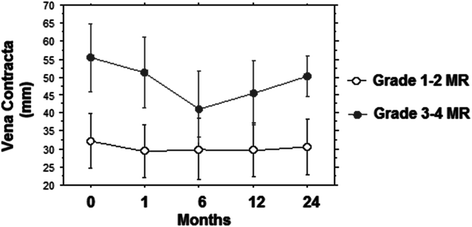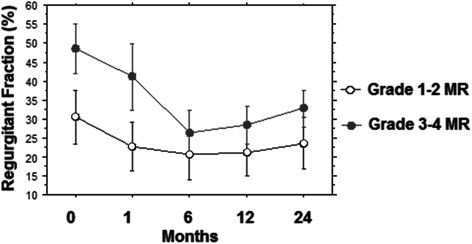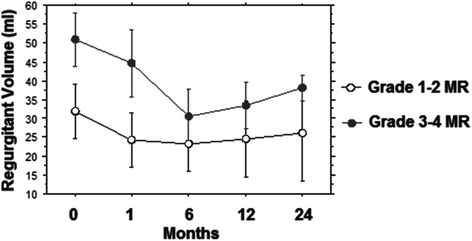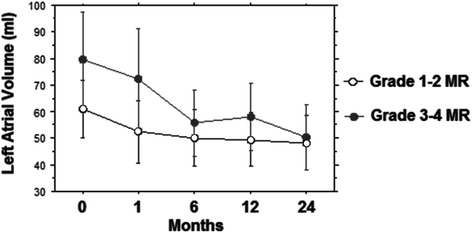The beneficial effects of TAVI in mitral insufficiency
- PMID: 26714887
- PMCID: PMC4696344
- DOI: 10.1186/s12947-015-0040-5
The beneficial effects of TAVI in mitral insufficiency
Abstract
Background: Previous studies have suggested that concomitant mitral regurgitation (MR) is a risk factor for acute transcatheter aortic valve implantation (TAVI) failure, but may improve afterwards. Aim of this study was to assess the prevalence, clinical meaning and modifications of MR in patients undergoing TAVI.
Methods: In a retrospective, two-center (Potenza-San Carlo and Roma- San Camillo) study, from January 2010 to June 2014 we enrolled 165 consecutive patients (age =80 ± 5 years, 74 males, Ejection Fraction 51 ± 9 %) referred for TAVI with either Medtronic Core-ReValving System (in 114 patients, 69%) or balloon-expandable Edwards SAPIEN/SAPIEN XT (in 51 patients, 31%). All patients underwent TTE and TEE assessment of MR (from 1, mild to 4 = severe according to ESC latest guidelines) with core lab reading by a single observer blinded to patient identity and status. Assessment was performed at baseline (24 h prior to intervention) and at 1, 6, 12 and 24 months.
Results: Mild-to-Moderate MR (grade 1-2) was present in 137 patients and Moderate-to-Severe MR (grade 3-4) was present in 28 patients. No significant differences were seen comparing perioperative mortality and morbidity between the two groups. In the group of preoperative MR grade 3-4 the mean decrease from MR pre-TAVI to MR at 1 month post-TAVI was 0.464 (p < 0.0001) and this improvement was persistent at 6 months (p < 0.0001) and at 12 months (p < 0.0001), with partial benefit loss at 1 and 2 years. The mean difference from Left Atrial volume post-TAVI at 1 month was 16.5 ml (p < 0.0001) and this improvement was persistent at 12 months 12.12 ml (p < 0.0001).
Conclusions: TAVI effectively treats the aortic valve but as a beneficial by product also ameliorates concomitant MR. The presence of moderate-to-severe MR does not increase the acute risk of failure of TAVI. In successful procedures, the MR improves immediately and persistently.
Figures







References
-
- Caballero-Borrego J, Gómez-Doblas JJ, Cabrera-Bueno F, García-Pinilla JM, Melero JM, Porras C, et al. Incidence, associated factors and evolution of non-severe functional mitral regurgitation in patients with severe aortic stenosis undergoing aortic valve replacement. Eur J Cardiothorac Surg. 2008;34:62–6. doi: 10.1016/j.ejcts.2008.03.055. - DOI - PubMed
Publication types
MeSH terms
LinkOut - more resources
Full Text Sources
Other Literature Sources
Miscellaneous

